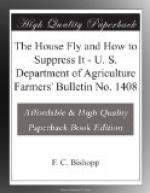[Illustration: FIG. 6.—Larvae, or maggots, of the house fly. About natural size. (Newstead.)]
The pupae (fig 7), or “sleepers,” are more or less barrel shaped and dark brown in color. In midsummer this stage usually lasts from 3 to 6 days. The pupa stage is easily affected by temperature changes and may be prolonged during hibernation for as long as 4 or 5 months. Numerous rearing experiments in various parts of the country have shown that the shortest time between the deposition of eggs and the emergence of the adult fly is 8 days, and 10 and 12 day records were very common.
The adult fly, upon emerging from the puparium, works its way upward through the soil or manure and upon reaching the air it crawls about while its wings expand and the body hardens and assumes its normal coloration. In from 2 1/2 to 20 days, as previously stated, the female is ready to deposit eggs. As in the case of other periods of its life history, so the preoviposition period is prolonged considerably by the lower temperatures of spring and fall. In midsummer, with a developmental period of from 8 to 10 days from egg to adult, and a preoviposition period of from 3 to 4 days, a new generation would be started every 11 to 14 days. Thus the climate of the District of Columbia allows abundance of time for the development of from 10 to 12 generations every season.
[Illustration: FIG. 7.—Pupae of the house fly. About natural size. (Newstead.)]
Flies usually remain near their breeding places if they have plenty of food, but experiments recently made at Dallas, Tex., show that they may migrate considerable distances; in fact, house flies, so marked that the particular individuals could be identified, have been recaptured in traps as far as 13 miles from the place where they were liberated.




